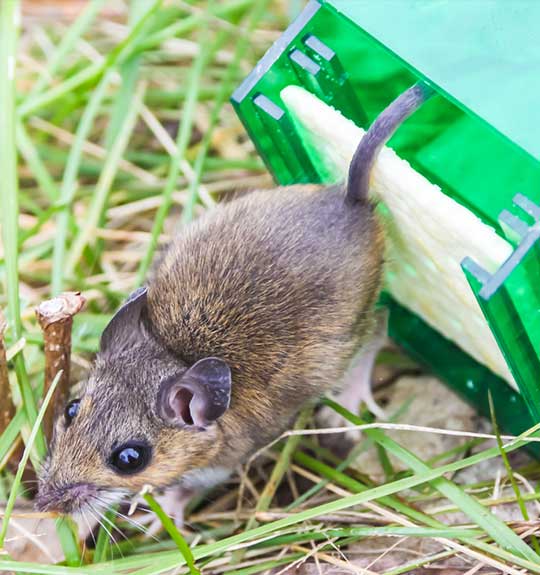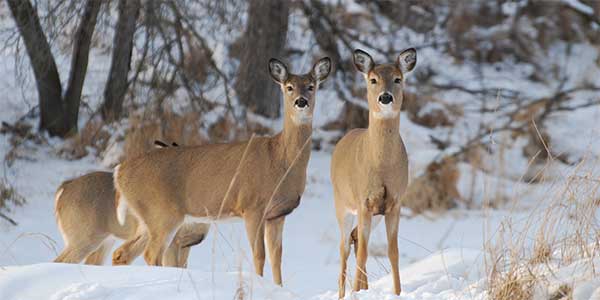Humane Rodent Solutions
Overview
HSI advocates that the default solution should be to implement humane methods of deterrence and eviction instead of killing them. This is for two important reasons:
- Killing mice and rats typically causes suffering. This may be brief but is often drawn out over hours, days or even — in the case of some poisons — weeks.
- Lethal methods do not offer a viable long-term solution. Treating the symptom by eliminating a single rat/mouse — or even an entire colony — is ultimately futile unless the conditions that encouraged them to take up residence in the first place are addressed. Over time, others will simply move into the vacated territory.

Prevention and Deterrence
Like all animals, rats and mice require food and shelter and will seek out easily accessible sources of both. Rats prefer to be outside but mice like to live indoors and can enter your home by squeezing through very small spaces, for example air vents, and gaps around gas and water pipes. Prevention is better than cure: seal off holes and don’t tempt mice and rats in with easily accessible food supplies. The food that we throw away in our garbage or compost bin and leave out for our companion animals provides rats and mice with a tempting buffet. Many rat ‘infestations’ are the result of bird-feeding.
As soon as a rat or mouse problem is identified, it is important to take swift action. Identify the source of food that attracted them and remove it. Humanely remove the animals and then seal up holes to keep others from gaining entry.
Home and Kitchen
- Mice need only around one tenth of an ounce of food each day: crumbs are enough to sustain them. Clean (and keep clean) all areas where food and crumbs may have dropped, such as under the toaster and down the sides of the cooker and fridge.
- Store rodent-susceptible food (e.g. crackers, cereal, pasta, bread, chocolate) in cupboards in metal or glass containers.
- Bags of dry cat/dog food should also be stored in rodent-proof containers and not left out in cellars, basements or cupboards.
- Do not leave out cat or dog food in dishes overnight.
- Rodents have been found to avoid the smell of peppermint, spearmint or eucalyptus. Soak cotton wool balls in one of these oils ensuring they smell very strongly and leave along work surfaces, underneath units and anywhere that could be an entry point. Refresh the oil for several weeks after you believe they have gone to discourage them from returning.
- Block all potential access holes with wire wool, ’mouse mesh’ (available online), or a strong sealant that will harden quickly. Don’t use caulk or other rubber or plastic fillers because mice can easily chew through them.
Please note: Plug-in ultrasonic devices are not reliable.
Lofts, Basements and Sheds
- Soak rags in a non-toxic repellent liquid (available from some hardware and DIY stores or online) and leave in the corners.
- Rub peppermint, spearmint or eucalyptus oil along beams and other areas where rodents travel.
Garden
- Stop feeding birds in your garden to encourage the rats to move on. Only resume once you are sure they have gone.
- If you choose to resume bird-feeding, do not throw food on the ground, put it in feeders with trays underneath and do not hang the feeders close to your house or trees. Put food out little and often and do not leave uneaten food on the ground overnight.
- Keep grass short, thin out shrubs, remove cover such as piles of wood and get rid of clutter.
- If you know where their runs are, expose the tunnels and place obstacles such as pebbles and leaves in the entrance/exit points (so as to cause an annoyance but not block the hole). Used cat litter can also be tipped down burrows. This will encourage them to relocate.
- Grow mint, spearmint and/or citronella plants.
- Animal-repelling products from garden centers and DIY shops can be scattered or sprayed but should obviously not be used if you have a companion cat or dog. Urine-soaked cat litter can also be an effective deterrent.
Live Capture and Release
Catching animals and releasing them away from the home should only be a last resort if you have not been able to encourage them to leave of their own accord. Whilst it is undoubtedly preferable to a slow and certain death from poisoning, there is no guarantee that indoor mice will survive in unfamiliar territory outside if they have been inside for generations, and their chances will be reduced further by cold weather. They may also leave behind young, dependent animals in the nest, who will perish. If you do need to address the situation urgently, either purchase a humane trap (available in some DIY/garden centers and hardware stores) or follow these steps for making a home-made version. Whichever trap you use, it must be checked first thing in the morning, last thing at night and at least once more during the day and the animal released as soon as possible.
- Use ‘mouse-mesh’ (available online) to cover air-vents and air bricks and use copper/wire wool or rapidly hardening sealer to block gaps around pipes in outside walls. Put draught excluders under outside doors to ensure that gaps are no more than 5mm.
- Place a small plastic or metal wastepaper bin, around 28 cm deep, where signs of mice have been found, with a little shredded paper and some food in the bottom, for example peanut butter (do not use cheese).
- Cover the top of the bin with a book, for example, leaving a 2cm gap on one side.
- Use a pile of newspapers to make a ‘staircase’ next to the bin so that they can climb to the top and peer in through the gap. Upon smelling the food they should drop down to reach it, landing on the shredded paper, which will cushion their fall and allow them to feel safe whilst they are captive.
- Captured mice should be released in the garden in dense vegetation (such as a hedge) or, even better, near a shed under which they can shelter, as far from the house as possible.
- If, through gentle examination and being careful not to be bitten, you are able to ascertain that a female mouse is lactating, which would indicate young in the nest, you must make a decision as to how you wish to proceed. The humane choices are to let her go and readdress the problem later or search for the nest and relocate the family to somewhere safe and contained so you can release mother and young when they have grown.
- After animals have been evicted or captured and released, it is vital that they are prevented from re-entering. Determining points of entry from outside to in is especially important.
Discover More
Humane Backyards
A humane backyard gives wildlife a safe place to live free from pesticides, chemicals, free-roaming pets, inhumane practices (such as trapping) and other threats.
Avoiding Conflict with Local Wildlife
Animal troubles in your neighbourhood? Bird feeders and unsecured pet food, garbage and grills may be bringing local wildlife to your back door.



